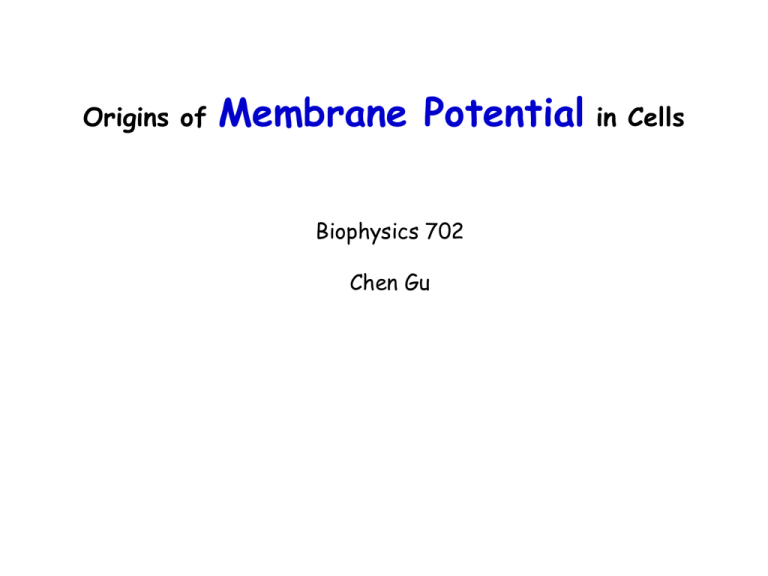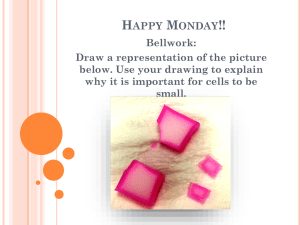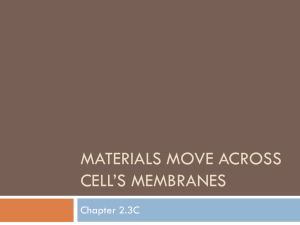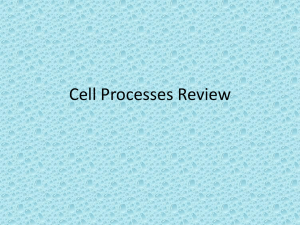Origin-of-Membrane-Potential
advertisement

Origins of Membrane Potential in Cells Biophysics 702 Chen Gu What is membrane potential? Why is it important? How is membrane potential generated? How do we calculate membrane potential? How does membrane potential encode signals? What are the carriers for membrane potentials? The membrane potential (Vm) is defined as Vm = Vin – Vout Vout = 0 extracellular Vin intracellular Resting membrane potential Depolarization Hyperpolarization -60 to –70 mV for neurons become more positive become more negative What is membrane potential? Why is it important? How is membrane potential generated? How do we calculate membrane potential? How does membrane potential encode signals? What are the carriers for membrane potential? The membrane potential results from a separation of positive and negative charges across the cell membrane Electrical and thermodynamic forces determine the passive distribution of ions C C1 C2 Diffusion down Chemical Gradient J I R V P R R J = C/R V . Q I = V/R ’s LAW . Q = P/R C1+ C2+ Diffusion + + + + + + + + I + + + down Electrical Gradient I = C/R + R Concept of an Equilibrium Potential for an ionic species: The potential at which the movement of ions across the membrane is in electrochemical equilibrium, i.e. the voltage necessary to result in no net movement of the ionic species across the membrane. Na+ Na+ Na+ Na+ Na+ Na+ Na+ Na+ Na+ Na+ Na+ Na+ Na+ Na+ Na+ -90 mV Out of Equilibrium Na+ Na+ Na+ +55 mV In Equilibrium Extracellular Intracellular - K K K K K K K Concentration gradient voltage gradient K K K K K K K K K + + + + + + + + + Negative to EK Positive to EK Maintaining the resting membrane potential gK K+ moves out of cell Reversal potential (No net movement of K+) EK K+ moves into cell gK Time Normal current injection Increased gK Voltage response K+ moves out of cell EK -102 mV -102 gK Time K+ moves into cell What is membrane potential? Why is it important? How is membrane potential generated? How do we calculate membrane potential? How does membrane potential encode signals? What are the carriers for membrane potential? Resting membrane potentials Nernst equations for biological ions: Anions: Cl- and proteins Cations: K+ diffusion potential RT [K]o Na+ diffusion potential Ek = ln F [K]i Ca2+ diffusion potential Na+/K+-ATPase RT [Na]o ENa = ln F [Na]i RT [Ca]o ECa = ln 2F [Ca]i RT [Cl]o ECl = ln -F [Cl]i -60 to -75 mV extracellular ENa = +56 Na+ (150) intracellular Na+ (18) EK = -102 K+ (3) K+ (135) ECl = -76 Cl- (120) ECl = +125 Ca2+ (1.2) Cl- (7) Ca2+ (0.1 µM) NSCC Na+,K+-ATPase Important: Ionic concentration differences across cell membranes determines the membrane potential The concentration differences of ions are due to the biophysics of the channels and pumps Guyton, Textbook of Physiology Nernst Equation E (ion) = RT/zF ln ([ion]outside/[ion]inside) Na+ Na+ Na+ Na+ Na+ Na+ Na+ Na+ Na+ @ 370 C RT/F= (27/z) Convert to log 2.3 x 27/z = 63 @ 0o C = 54 @ 24oC = 59 @ 37oC = 63 E (ion) = 63 log ([ion]outside/[ion]inside) The “Voltage Diagram” +72 ENa+ = 63 log [142] o/[ 10 ] i = +73+ mv ENa 0 ECl- = 63 log [103] o/[ 4 ] i = -89 mv -1 -89 -90 EclVr (i.e. resting Vm) -97 EK+ EK+ = 63 log [ 4 ] o/[140] i = -97 mv Time The “Voltage Diagram” ENa+ (Equilibrium Potential for Na+) +72 - -+ + - + - + 0 -89 -90 ECl- (Equilibrium Potential for Cl- ) Vr (i.e. resting Vm) -97 EK+ (Equilibrium Potential for K+) Time Maintaining the resting membrane potential The Goldman-Hodgkin-Katz Equation: The steady state membrane potential for a given set of ionic concentrations inside and outside the cell and the relative permeability of the membrane to each ion RT pK[K+]o + pNa[Na+]o + pCl[Cl-]i Vm = ln F pK[K+]i + pNa[Na+]i + pCl[Cl-]o -60 to -75 mV extracellular ENa = +56 Na+ (150) intracellular Na+ (18) EK = -102 K+ (3) K+ (135) ECl = -76 Cl- (120) ECl = +125 Ca2+ (1.2) Cl- (7) Ca2+ (0.1 µM) NSCC Na+,K+-ATPase Three Primary reasons for a net negative potential across the membrane (1) (2) Electrongenic Na/K ATPase High IC [Anions] (3) Relative Permeabilities of dominant cations 3 Na+ EXTRACELLULAR SPACE Na+ +++++++++++++++++++++++++++++++++++++++++++ ATPase Lipid Bilayer -------------------------------------------------------------Anion2 K+ K+ AnionINTRACELLULAR SPACE Anion- Anion- Anion- Anion- Changes in membrane potential due to ion movement Depolarization: Initiators: Na+ channels nonselective cation channels (NSCC) Na+,K+-ATPase Terminators: K+ channels Cl- channels -60 to -75 mV extracellular ENa = +56 Na+ (150) intracellular Na+ (18) EK = -102 K+ (3) K+ (135) ECl = -76 Cl- (120) ECl = +125 Ca2+ (1.2) Cl- (7) Ca2+ (0.1 µM) NSCC Na+,K+-ATPase What is membrane potential? Why is it important? How is membrane potential formed? How do we calculate membrane potential? How does membrane potential encode signals? What are the carriers for membrane potential? Types of electrical signals • Graded potentials: Variable-strength signals that lose strength as they travel through the cell. a. b. c. d. e. f. Can be depolarizations (Na+ channel) or hyperpolarizations (K+ or Cl- channel) Begins on the cell membrane at the point where ions enter from the extracellular fluid (local current or electrotonic current) The strength or amplitude is directly proportional to and is determined by the number of charges that enter the cell, which in turn is determined by the number of receptors which are opened. (concentration of the neurotransmitters and density of the receptors) The size of the graded potential decreases as it spreads out from its point of origin Graded potentials travel through the neurons until they reach the trigger zone, the point where an action potential is generated. Depending on the strength of the graded potential, it either triggers an action potential or dies out (threshold potential). Can be summed: spatial summation and temporal summation • Action potentials: Signals that travel for long distances through the neuron without losing strength. a. b. c. d. Rapid electrical signals that pass along the axon to the axon terminal. Identical to each other and do not diminish in strength when traveling through the cell The strength of the graded potential that initiates an action potential has no influence on the action potential as long as it is above threshold. All-or-none Comparison of graded potential and action potential Feature Graded Potential Action Potential Type of signal Input signal Conduction signal Where it occurs Usually dendrites and cell body. Axon hillock, initial segment and entire length of axon Types of gated ion channels Mechanically or chemically gated channels Voltage-gate channels Ions involved Usually Na+, K+, and Cl- Na+ and K+ Type of signal Depolarizing (Na+ ) or hyperpolarizing (K+, Cl- ) Depolarizing Strength of signal Depends on initial stimulus; can be summed Is always the same as long as graded potential is above threshold; cannot be summed What initiates the signal Entry of ions through chemically or mechanically gated ion channels Above-threshold graded potential arrives at the integration zone Unique characteristics No minimum level required to initiate a graded potential Two signals coming close together in time will sum Threshold stimulus required to initiate action potential Refractory period: two signals too close together in time cannot sum Initial stimulus strength is indicated by frequency of a series of action potentials What is membrane potential? Why is it important? How is membrane potential formed? How do we calculate membrane potential? How does membrane potential encode signals? What are the carriers for membrane potentials? Voltage-gated ion channels: currents Inward currents -10 -100 INa,t Voltage (mV) -10 -100 Na+ Outward currents -10 Voltage (mV) -100 Na+/K+ Ih K+ IK IA INa,p IM ICa,L ICa,N ICa,T Voltage (mV) Ca2+ IC Voltage-gated ion channels: structure Perez-Reyes, Cell Mol Life Sci 56, 660-669, 1999 The structure of mammalian Kv1.2/Kvb2 Long et al, 2005 Science Voltage-gated ion channels: the superfamily Yu et al., Pharmacol Rev 57: 387-395, 2005 Voltage-gated ion channels: structure of Ca2+ channels Skeletal muscle L-type Cardiac muscle L-type a1s b b Bers and Perez-Reyes, Cardiovasc. Res. 42, 339-360, 1999 Ligand-gated ion channels (ionotropic receptors) Bind to neurotransmitters Receptor channels Mediate fast synaptic transmission . .. . . ions Postsynaptic terminal Presynaptic terminal ICa a1B Ca2+ .. . . . NMDAR AMPAR Ca2+ DAG ligand Ca2+ Gq/11 IP3 mGluR1 5 mV 20 ms ionotropic glutamate receptors GluR1 GluR2 GluR3 GluR4 10% AMPA: a-amino-3-hydroxy-5-methyl-4-isoxazoleproprionic acid GluR5 GluR6 GluR7 KA1 KA2 kainate NR1 NR2A NR2B NR2C NR2D NMDA: N-methyl-D-aspartate Coincidence detector because of voltage dependent Mg2+ block NH2 TM4 NR2 NR1 NH2 extracellular TM3 NR1 TM1 NR2 TM1 NR1 TM4 TM2 TM1 intracellular TM2 TM4 TM3 TM1 TM4 TM3 NR2 Mg2+ TM3 TM1 TM1 NR1 TM3 TM3 TM4 COOH COOH NR2 TM4 Cys-loop superfamily Muscle-type subfamilies Cation channels Nicotinic acetylcholine receptor I, epithelial a9; II, neuronal a7,8; III, neuronal a2–6 and b2–4 III-1: a2,3,4,6; III-2, b2,4 III-3, a5, b3; IV, muscle a1, b1, g, d, and e IV-1, a1 IV-2, g, d, e IV-3, b1. homo-oligomeric a7 NH2 COOH extracellular TM1 TM2 TM3 TM4 intracellular hetero-oligomeric a4b2 Corringer et al., Annu. Rev. Pharmacol. Toxicol. 40:431-458, 2000 5-HT3 serotonin receptor 5-HT3A, 5-HT3B Anion channels GABAA receptor Glycine receptor Neuronal type g a b d TM4 a NH2 TM3 TM2 TM4 TM3 a TM1 g TM4 TM2 TM3 TM3 TM1 TM2 COOH TM1 TM4 b TM1 TM2 TM2 TM2 TM1 TM3 d TM4 TM1 a TM3 TM4 P2X receptors a P2X2 P2X3 P2X5 P2X6 P2X1 b Cysteine rich extracellular loop P2X4 Plasma membrane P2X7 NH2 Each channel may contain three to six subunits C tail length varies Khakh et al., Pharmacol. Rev. 53, 107-118. 2001 • Activated by ATP • Cation nonselective • ~6.5% of current is carried by Ca2+ Anion channels GABAA receptor ClC-5 CLC Text books: Chapter 6 Fundamental Neuroscience Chapter 7 Principles of Neural Science








